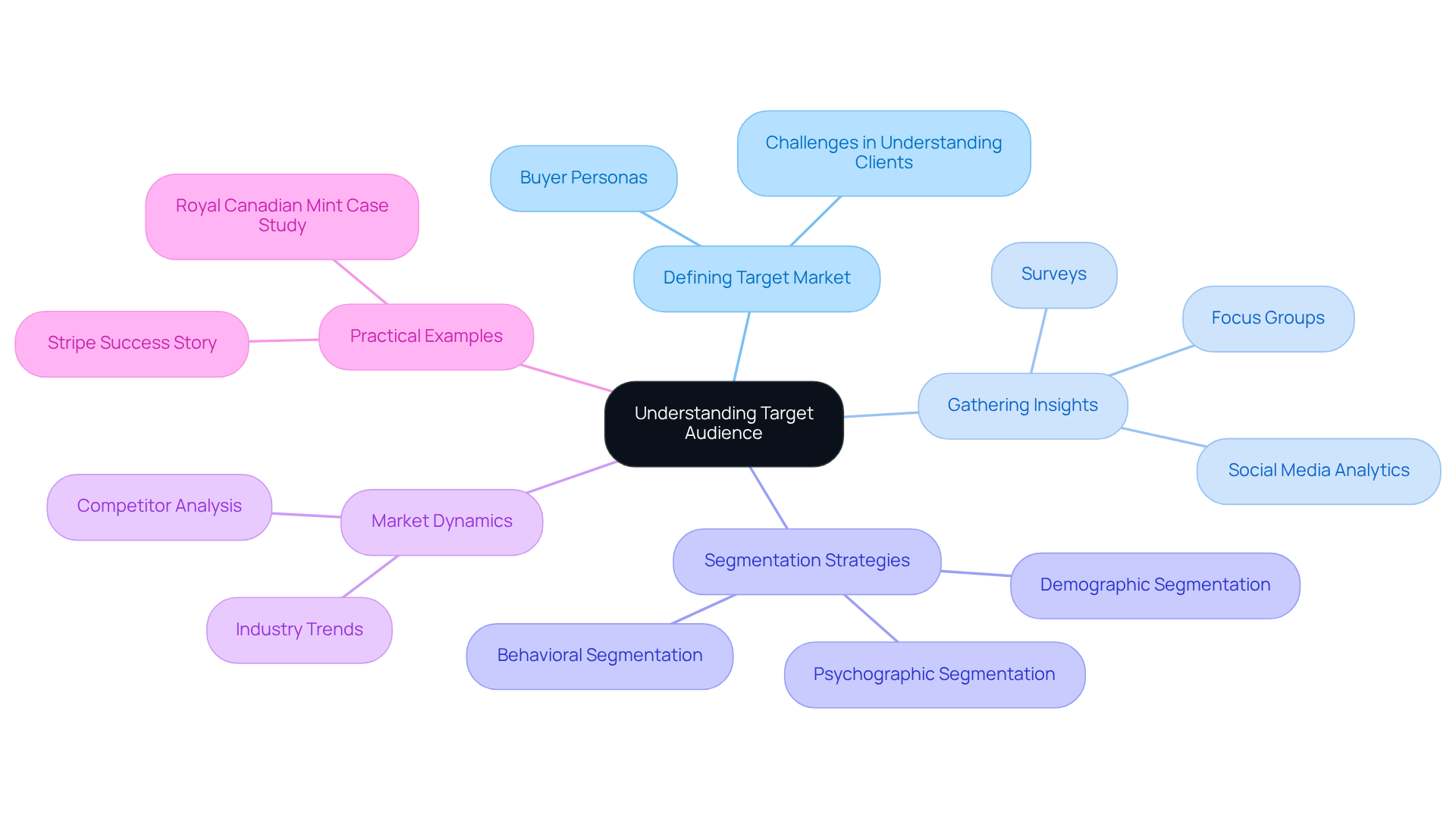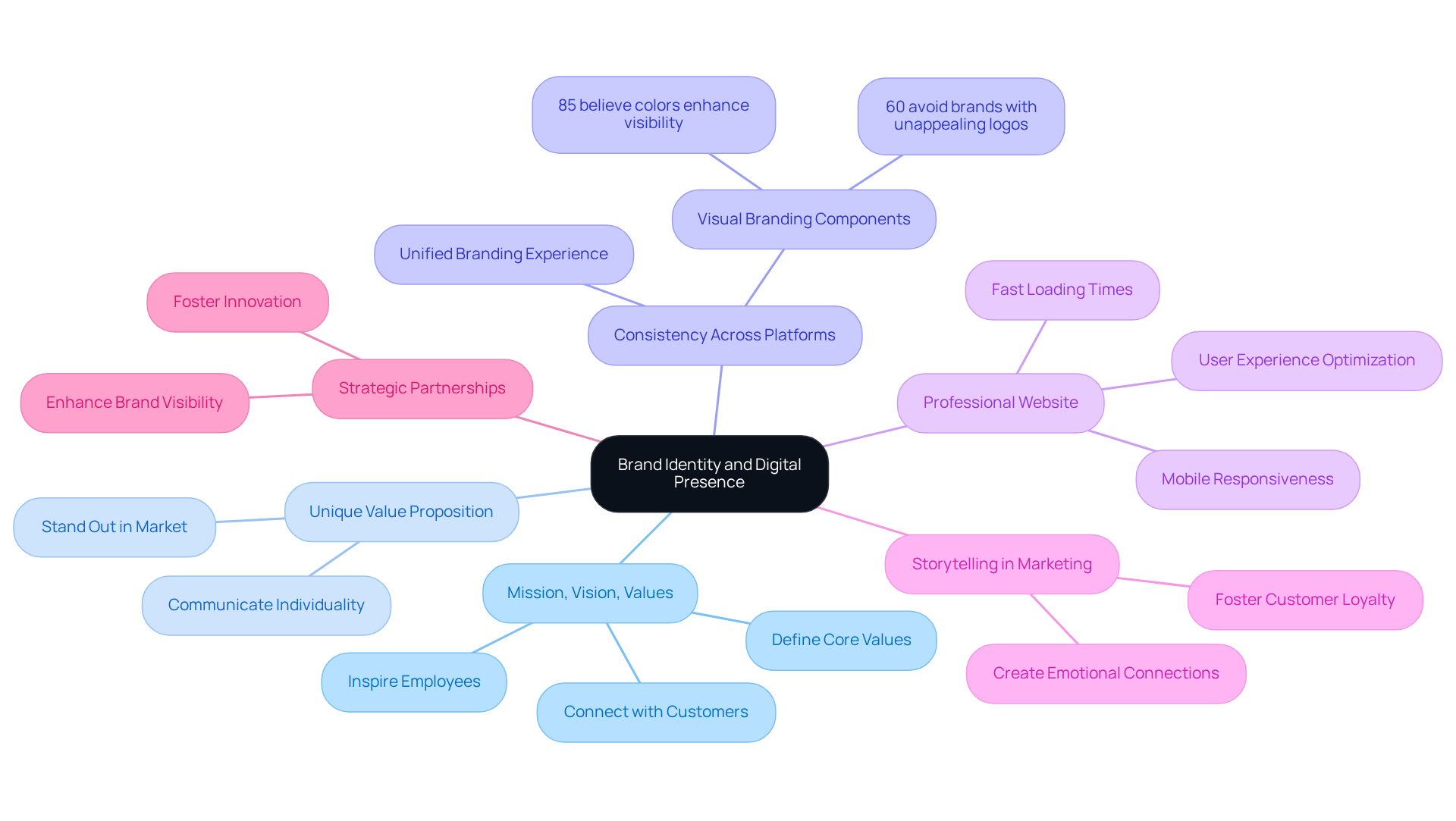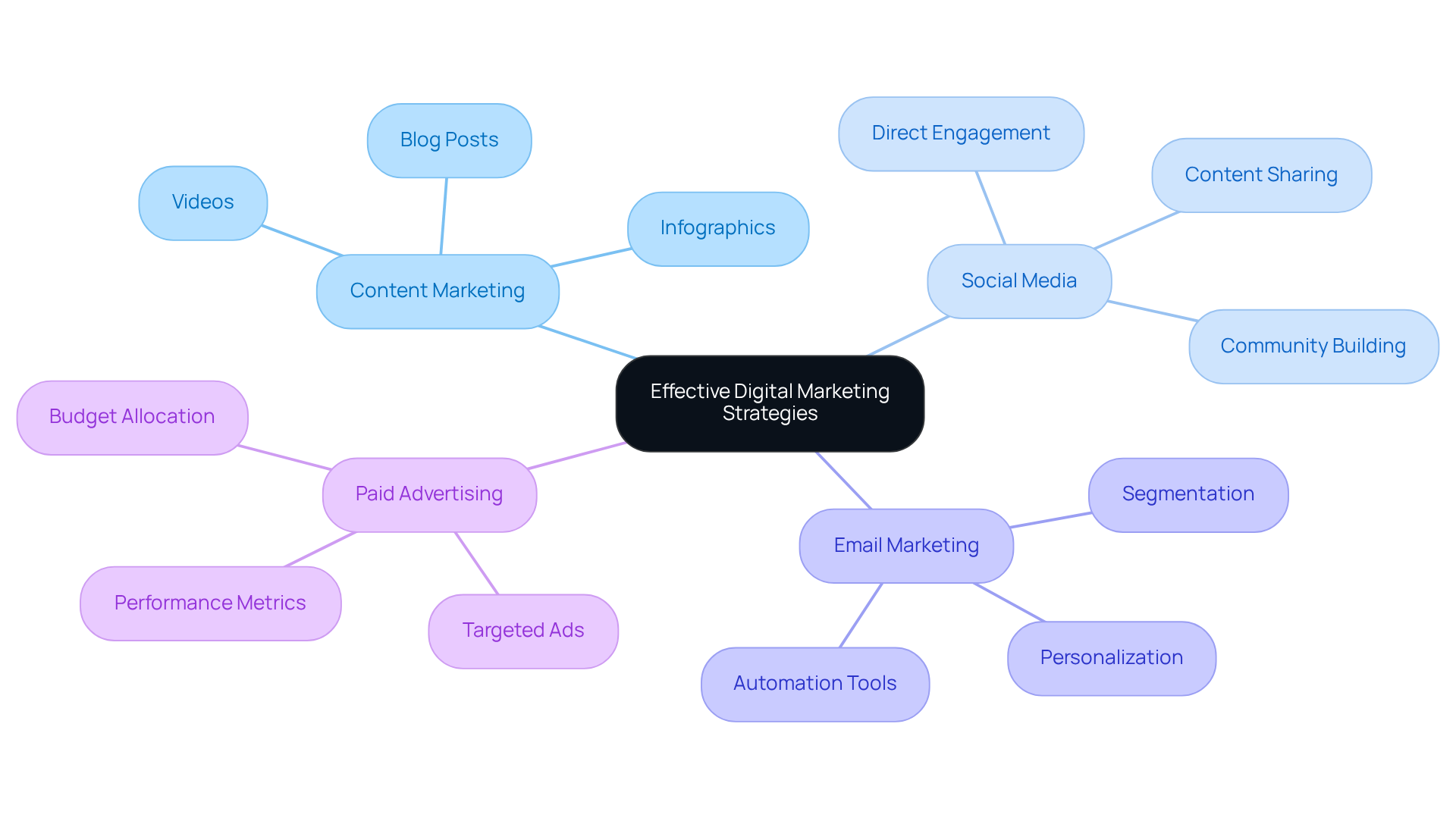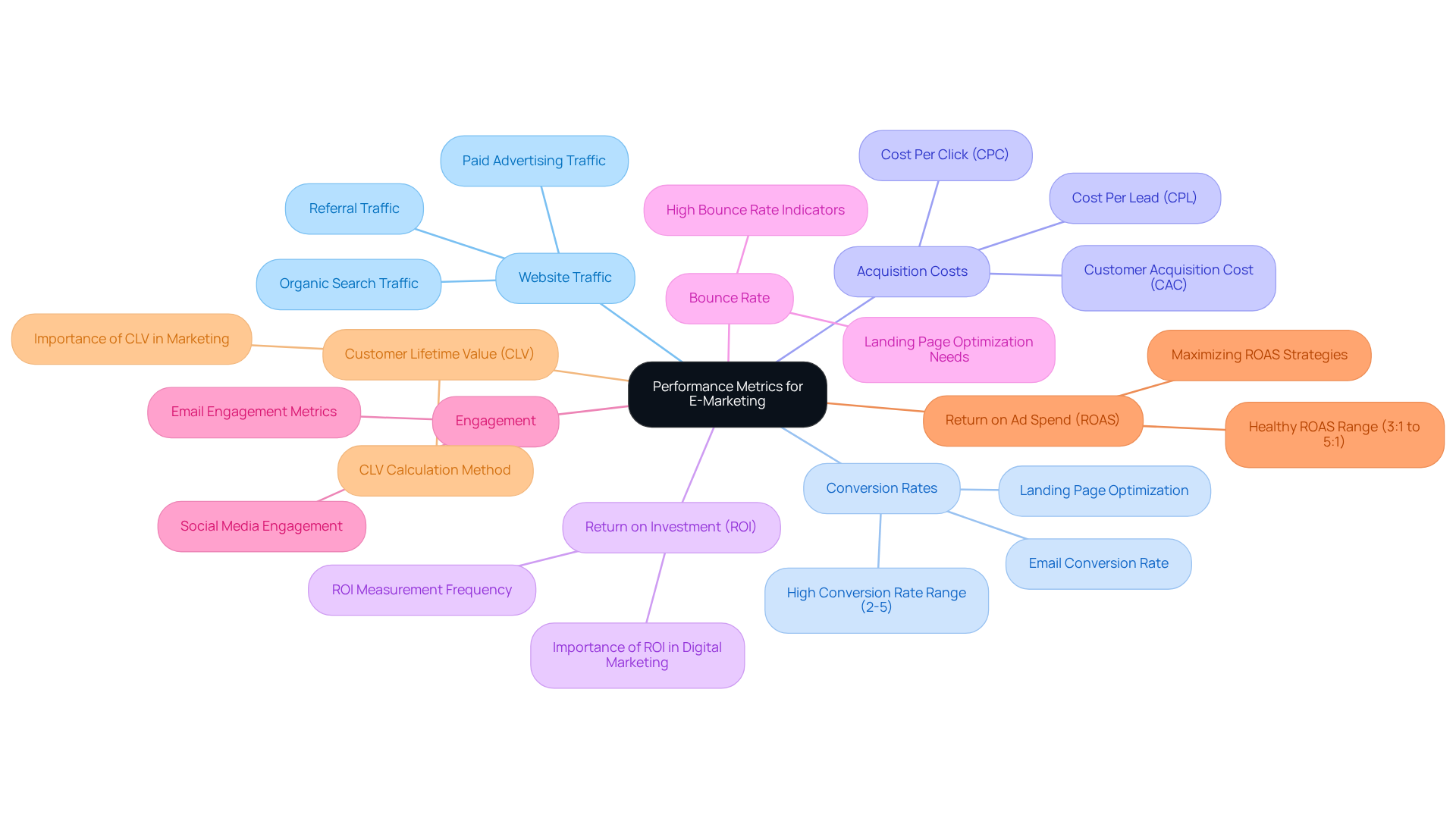Overview
In the ever-evolving landscape of technology, many startups grapple with the challenge of effectively reaching their target audience. This struggle can lead to feelings of frustration and uncertainty, as founders seek to carve out a space in a competitive market. Understanding this pain point is crucial, as it underscores the importance of strategic eMarketing.
To address these challenges, we present four essential eMarketing strategies designed specifically for tech startups:
-
Understand Your Target Audience:
By engaging in thorough audience segmentation, you can tailor your messaging to resonate deeply with potential customers. This nurturing approach fosters a connection that can lead to lasting relationships. -
Establish a Compelling Brand Identity:
A strong digital presence not only captures attention but also builds trust. Your brand should reflect the values and vision that you hold dear, inviting others to join you on your journey. -
Implement Effective Digital Marketing Tools:
Multi-channel marketing ensures that your message reaches your audience wherever they are, creating a seamless experience that enhances engagement. -
Monitor Performance Metrics:
Regular evaluation allows you to understand what resonates with your audience and where adjustments may be needed. This iterative process is not just about numbers; it’s about nurturing your growth and adapting to the needs of your customers.
By embracing these strategies, you can significantly enhance customer engagement and drive sustainable growth. Remember, you are not alone in this journey; with the right tools and insights, success is within your reach.
Introduction
In the fast-paced world of technology startups, navigating the complexities of eMarketing can feel like an uphill battle. It’s not just a challenge; it’s a significant hurdle that many founders face. Understanding the nuances of target audiences and market dynamics is essential for survival and growth. Without this understanding, the risk of falling behind is all too real.
This article explores four essential eMarketing strategies designed to empower tech startups. These strategies will help you establish a strong digital presence, connect authentically with your audience, and drive sustainable growth.
But what happens when traditional marketing tactics fall short in capturing the attention of a savvy, digital-first consumer base? It can leave you feeling frustrated and overwhelmed. Yet, there is hope. Together, we can explore solutions that resonate with your unique journey.
Understand Your Target Audience and Market Dynamics
To effectively engage your audience, it’s essential to start by clearly defining your target market. Think about the challenges you face in understanding your prospective clients. Utilizing surveys, focus groups, and social media analytics can help you . By using emarketing to segment your audience based on demographics, interests, and behaviors, you can create detailed buyer personas. This thoughtful approach not only aids in understanding their pain points and motivations but also allows you to craft tailored messaging and product offerings. For instance, a tech startup might find that their target audience deeply values user-friendly interfaces and strong support, insights that can significantly influence product development and marketing strategies.
Moreover, staying attuned to market dynamics is crucial. Consider how analyzing competitors and industry trends can provide you with valuable insights into what truly resonates with your audience. Employing tools like Hootsuite, Sprout Social, and Brandwatch, along with Google Trends and social listening platforms, can empower you to adjust your strategies proactively. Indeed, research shows that firms efficiently dividing their audience using emarketing are 2.3 times more likely to comprehend buyer intent and 1.6 times more likely to grasp client challenges, leading to enhanced engagement and satisfaction. Additionally, segmented campaigns in emarketing have shown the potential to achieve 101% more clicks than their non-segmented counterparts. By consistently refining your segmentation strategies, you can ensure that your emarketing efforts align with the evolving needs of your target market.
A practical example of successful segmentation can be seen with the Royal Canadian Mint. They leveraged customer data to identify their highest-value customers, resulting in the remarkable acquisition of 140,000 prospects in a single campaign. This illustrates the tangible benefits of implementing effective audience segmentation strategies. Remember, you’re not alone in this journey; many have faced similar challenges and have found success through thoughtful engagement and segmentation.

Establish a Compelling Brand Identity and Digital Presence
Creating a compelling identity for your startup begins with a heartfelt understanding of its mission, vision, and values. Many founders feel overwhelmed in a crowded market, unsure of how to stand out. This is where a unique value proposition becomes essential; it should convey what makes your business truly special. Consistency across all digital platforms—your website, social media, and emarketing materials—is vital. Think of it as creating a warm, inviting space that reflects your identity's personality, with a cohesive color palette, typography, and messaging. It's significant to note that 85% of purchasers believe colors enhance visibility, underscoring the importance of visual branding components that resonate with your audience.
Investing in a professional website is not just a necessity; it's the cornerstone of your digital presence. Imagine a space where your customers feel welcomed and understood. Ensure your website is optimized for user experience (UX), making navigation easy, loading times fast, and mobile responsiveness a priority. By incorporating emarketing strategies such as SEO best practices, you’ll enhance your visibility in search engine results, making it easier for potential customers to discover you. Additionally, 60% of consumers avoid companies with unappealing logo designs, highlighting the importance of investing in professional design for your marketing materials.
Consider how tech startups can harness the power of storytelling in their emarketing strategies. This approach can create emotional connections with users, fostering greater customer loyalty. For instance, RNO1's partnerships with industry leaders like Microsoft and Airbnb showcase how strategic collaborations can elevate a company's digital presence and spark innovation. By leveraging these partnerships, startups can enhance their identity and reach broader audiences, creating a sense of belonging.
As we look toward 2025, the importance of emarketing for a robust digital presence is clearer than ever. Companies that connect genuinely with their audience through consistent messaging are more likely to thrive. With 64% of consumers forming with their preferred brands, tapping into this connection through strategic emarketing can significantly influence client retention and sales. Furthermore, 94% of customers express loyalty to transparent brands, emphasizing the critical role of honesty in building brand loyalty.
To implement these nurturing strategies, tech startup founders should:
- Clearly define their mission, vision, and values, allowing their true essence to shine.
- Develop a unique value proposition that stands out in the market, showcasing their individuality.
- Ensure consistency in branding across all platforms, creating a unified and welcoming experience.
- Invest in a professional website and branding materials that reflect their values and aspirations.
- Utilize storytelling in content promotion to forge emotional connections with users, making them feel understood.
- Leverage strategic partnerships to enhance brand visibility and innovation, fostering a sense of community.

Implement Effective Digital Marketing Strategies and Tools
To enhance your emarketing initiatives, you may find that adopting a is essential. Many startup founders face the challenge of standing out in a crowded market, and this approach can help. It should encompass:
- Content marketing
- Social media
- Email marketing
- Paid advertising
Start by producing high-quality, valuable content that addresses your audience's challenges and interests. Consider creating:
- Blog posts
- Infographics
- Videos
These should not only demonstrate your expertise but also engage potential customers meaningfully.
Social media platforms can be a nurturing space to foster direct engagement with your audience. By sharing your content, responding to comments, and actively participating in relevant discussions, you can cultivate a supportive community around your brand. Email promotion also plays a crucial role in your strategy; segmenting your email list allows you to deliver personalized messages that resonate with different audience segments. Moreover, utilizing automation tools can simplify your campaigns and improve your ability to monitor performance metrics efficiently, bringing you peace of mind.
As we look ahead to 2025, the significance of a unified multi-channel emarketing approach cannot be overstated, especially for tech startups striving to establish a strong digital presence. Companies that interact with clients across various channels are expected to experience a 9.5% yearly rise in revenue, compared to just 3.4% for those with less efficient approaches. By implementing these nurturing practices, tech startups can significantly enhance client acquisition and retention, ultimately driving sustainable growth. Remember, you are not alone in this journey; many have walked this path and found success through these strategies.

Monitor Performance Metrics and Adapt Strategies for Growth
Establishing key performance indicators (KPIs) can feel daunting, yet it’s essential for assessing the effectiveness of your emarketing strategies. You might find yourself overwhelmed by metrics like website traffic, conversion rates, acquisition costs, and (ROI). Utilizing analytics tools such as Google Analytics can provide you with the clarity you need in your emarketing efforts, allowing you to track these metrics effectively and offering valuable insights into user behavior and engagement.
Regularly reviewing performance data is crucial for identifying trends and areas needing improvement. Perhaps you've noticed a high bounce rate, which could signal that your landing pages need a little optimization. A strong conversion rate, typically between 2% and 5%, is vital for evaluating the effectiveness of your campaigns. Being responsive to these insights is key; if a specific social media platform generates higher engagement, reallocating resources to that channel can enhance your overall performance. Remember, continuous monitoring and adaptation not only keep your startup agile but also ensure you remain aligned with market dynamics, ultimately driving emarketing growth and success in a competitive landscape.
Moreover, understanding a healthy Return on Ad Spend (ROAS), which usually ranges from 3:1 to 5:1, can serve as a benchmark for evaluating your marketing effectiveness. Tracking [Customer Lifetime Value (CLV)](https://newpathdigital.com/digital-marketing-kpis) is also important, as it estimates the total revenue expected from a customer relationship, helping you justify your customer acquisition costs. By incorporating these metrics into your strategy, you can make informed decisions that propel your startup forward, fostering a sense of community and support along the way.

Conclusion
Navigating the complexities of eMarketing can feel overwhelming for tech startups striving to succeed in a competitive environment. Many founders grapple with understanding their audience and establishing a unique brand identity, which can lead to frustration and uncertainty. However, by embracing effective eMarketing strategies, you can transform these challenges into opportunities for growth and connection.
Understanding your audience through detailed segmentation and market analysis is crucial. It’s not just about attracting new customers; it’s about fostering lasting relationships that resonate with your target market. A compelling brand identity can make all the difference in a crowded space, helping you stand out and connect with potential customers on a deeper level. Additionally, a robust digital presence enhances your visibility and engagement, allowing your brand to shine across various platforms.
Adopting a multi-channel marketing strategy broadens your outreach, ensuring that your message reaches potential customers wherever they are. And remember, continuously monitoring performance metrics is essential. This adaptability allows you to align your strategies with market demands, maximizing your return on investment and ensuring that you remain responsive to your audience's needs.
In conclusion, embracing these essential eMarketing strategies is not just a necessity; it’s a pathway to sustainable success. By prioritizing audience understanding, brand consistency, and strategic adaptability, you can navigate the digital landscape with confidence. The journey may be challenging, but with a thoughtful approach to eMarketing, the potential for growth and innovation is truly boundless. Together, let’s embark on this journey, nurturing your startup's potential and fostering a community of support and success.
Frequently Asked Questions
Why is it important to understand your target audience?
Understanding your target audience is essential for effectively engaging them. It helps in defining your market, identifying challenges, and crafting tailored messaging and product offerings that resonate with their pain points and motivations.
What methods can be used to gather insights about prospective clients?
You can gather insights through surveys, focus groups, and social media analytics. These methods help in understanding audience demographics, interests, and behaviors.
What is the purpose of creating buyer personas?
Creating buyer personas helps in segmenting your audience and understanding their challenges and motivations. This allows for more effective marketing strategies and product development.
How can analyzing competitors and industry trends benefit your marketing strategy?
Analyzing competitors and industry trends provides valuable insights into what resonates with your audience, enabling you to adjust your strategies proactively and stay relevant in the market.
What tools can assist in understanding market dynamics?
Tools like Hootsuite, Sprout Social, Brandwatch, Google Trends, and social listening platforms can help you analyze market dynamics and audience engagement effectively.
How does audience segmentation impact marketing effectiveness?
Research shows that firms that effectively segment their audience are 2.3 times more likely to understand buyer intent and 1.6 times more likely to grasp client challenges, leading to enhanced engagement and satisfaction. Segmented campaigns can achieve 101% more clicks than non-segmented ones.
Can you provide an example of successful audience segmentation?
The Royal Canadian Mint successfully leveraged customer data to identify their highest-value customers, resulting in the acquisition of 140,000 prospects in a single campaign, demonstrating the benefits of effective audience segmentation strategies.




